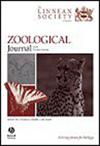Exploring the relationship between environment and brain morphology in anurans: a comparative phylogenetic approach
IF 3
2区 生物学
Q1 ZOOLOGY
引用次数: 0
Abstract
The correlation of ecological and behavioural characteristics with morphological features of brain structures has been recurrently corroborated for different vertebrate taxa, such as mammals, birds, and fishes. Here, we asked whether such correlations can also be detected in amphibians, an animal group of great interest due to its great behavioural and ecological diversity. We analysed the shape of two brain regions, cerebellum and optic tectum, of 67 species from 32 families of the order Anura (frogs and toads), applying 2D geometric morphometrics in a phylogenetic context. We found species that share similar environments and daily patterns have a similarly shaped cerebellum and optic tectum, with diurnal and arboreal species with more varied brain shapes. We did not find a correlation between activity mode or lifestyle with shape for both brain regions; however, we found that shared ancestry had an influence in their evolution. Future studies including a higher number of species from each ecological group, and from more families, would help to better clarify whether the patterns found here are a general rule for anurans.探索环境与无尾目动物大脑形态之间的关系:系统发育比较方法
在哺乳动物、鸟类和鱼类等不同脊椎动物类群中,生态和行为特征与大脑结构形态特征的相关性已被反复证实。在这里,我们想知道这种相关性是否也能在两栖类动物中检测到,两栖类动物因其行为和生态多样性而备受关注。我们在系统发育的背景下应用二维几何形态计量学分析了蛙目(青蛙和蟾蜍)32 个科 67 个物种的小脑和视神经乳头这两个脑区的形状。我们发现,具有相似环境和日常活动模式的物种具有相似形状的小脑和视神经乳头,而昼伏夜出和树栖物种的大脑形状差异更大。我们没有发现这两个脑区的活动模式或生活方式与形状之间的相关性;但是,我们发现共同的祖先对它们的进化有影响。未来的研究将包括更多来自每个生态类群和更多科的物种,这将有助于更好地阐明这里发现的模式是否是无尾类的普遍规律。
本文章由计算机程序翻译,如有差异,请以英文原文为准。
求助全文
约1分钟内获得全文
求助全文
来源期刊
CiteScore
6.50
自引率
10.70%
发文量
116
审稿时长
6-12 weeks
期刊介绍:
The Zoological Journal of the Linnean Society publishes papers on systematic and evolutionary zoology and comparative, functional and other studies where relevant to these areas. Studies of extinct as well as living animals are included. Reviews are also published; these may be invited by the Editorial Board, but uninvited reviews may also be considered. The Zoological Journal also has a wide circulation amongst zoologists and although narrowly specialized papers are not excluded, potential authors should bear that readership in mind.

 求助内容:
求助内容: 应助结果提醒方式:
应助结果提醒方式:


